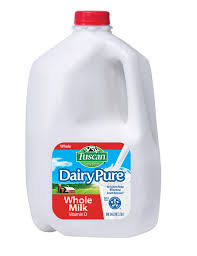
Full fat vitamin D milk is only 3 percent fat. Then we move down to 2 percent milk, which folks thought was better for health during the rise of the fear of fat from animal products in the 1970s. We see on shelves 1 percent milk and even skim milk, which is about a half a percent fat. Skim milk facts :
Before processing, skim milk has a very unappetizing blueish color, a chalky taste, and watery texture that doesn’t resemble natural milk at all. So, to whiten, thicken, and make it taste a little more normal, powdered milk solids are often mixed into the milk. What’s so bad about powdered milk? Well, in the manufacturing process, liquid milk is forced through tiny holes at very high pressure, which causes the cholesterol in the milk to oxidize, and toxic nitrates to form. Oxidized cholesterol contributes to the buildup of plaque in the arteries, while unoxidized cholesterol from unprocessed foods is actually an antioxidant to help fight inflammation in the body. The proteins found in powdered milk are so denatured that they are unrecognizable by the body and contribute to inflammation. Finally there is non fat milk, which has no fat at all inside of it, and barely tastes like milk at all. In fact, they add milk sugars to nonfat milk to make it taste like milk again.
When consuming dairy products, I suggest go for the highest quality that you can afford. Try for grass fed, pastured products. Then move up to full fat, organic, raw, grass fed pastured versions. See if it makes a difference in how you feel afterwards. Some of my lactose intolerant clients have zero reaction to raw unpasteurized dairy products.
I want to hear from you!
Blessings,
KJ Landis

 RSS Feed
RSS Feed